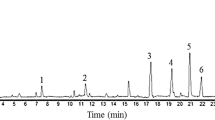Abstract
Sun-dried guava (Psidium guajava L.) and eucalyptus (Eucalyptus globulus L.) leaves were evaluated as repellent and toxic materials against the rice weevil, Sitophilus oryzae L., and the granary weevil, Sitophilus granarius L. under laboratory conditions. LC50 values of sun-dried guava and eucalyptus leaves admixed with rice grains against S. oryzae were 2.251 and 4.140g leaves/100g rice grains, respectively, while they were 2.278 and 4.857 g leaves/100 g rice grains in the case of S. granarius, respectively. Guava leaves were more toxic for both species than eucalyptus leaves. Eucalyptus leaves were more repellent than guava leaves. Both test materials at 15 g/100 g depressed the progeny development of the test insects.
Résumé
Les fauiles morqueés de goyave (Psiduim guajava L.) et de (Eucalyptus globulus) séché an soleil étaient évalués comme des matiéres répulsives et toxiques contre le charancon du riz Sitophilus oryzae et le charancon du grenier Sitophilus granarius sous les conditions du laboratoire. Le LC50 des feuilles de goyave et de eucalyptes séché an soleil melangevient avec les groeins du riz contre S. oryzae etaiant 2.251 et 4.140 g feuilles/100 g grains due riz, respectivement. Il paraît que les feiulles de goyave étaient plus toxiques pour les deux espèces que les feuilles de Eucalyptus. Les resultats montrent encore que l’acturté répulsif des feuilles de eucalyptus étaient plus que celles des feuilles de goyave. L’augmentation due doses de deux materiaux (15 g/100 g) surbaissent la postérité des insectes examines.
Similar content being viewed by others
References
Abbott W. S. (1925) A method of computing the effectiveness of an insecticide. J. econ. Ent. 18, 265–267.
Abdel-Gawaad A. A. and Khatab H. A. (1985) Soil and plant protection methods in ancient Egypt. Second Inter. Congr. Soil Poll., Part II. pp. 19–22.
Don-Pedro K. N. (1985) Toxicity of some citrus peels to Dermestes maculatus and. Callosobruchus maculatus. J. Stored Prod. Res. 21, 31–34.
Duncan D. B. (1956) Multiple range and multiple F-test. Biometrics 11, 1–42.
Finney D. J. (1971) Probit analysis. 3rd ed. Cambridge University Press, London.
Golob P. and Webley D. J. (1980) The use of plants and minerals as traditional protectants of stored products. Rep. Trop. Prod. Inst. 138, 32.
Golob P., Mwambula J., Maango V. and Nuguluhe F. (1982) The use of locally available materials as protectants of maize grain against insect infestation during storage in Malawi. J. Stored Prod. Res. 18, 67–74.
Taylor T. A. (1975) Effects of orange and grapefruit peels on Callosobruchus maculatus infestation of cowpea. Ghana J. Agric. Sci. 8, 169–172.
Teotia T. P. S. and Pandey G. P. (1977) Dharek fruit powder as a protectant of rice against the infestation of rice weevil, Sitophilus oryzae. Indian J. Ent. 39, 223–225.
Author information
Authors and Affiliations
Rights and permissions
About this article
Cite this article
Sharaby, A. Evaluation of Some Myrataceae Plant Leaves as Protectants Against the Infestation by Sitophilus oryzae L. and Sitophilus granarius L.. Int J Trop Insect Sci 9, 465–468 (1988). https://doi.org/10.1017/S1742758400010973
Received:
Revised:
Published:
Issue Date:
DOI: https://doi.org/10.1017/S1742758400010973




